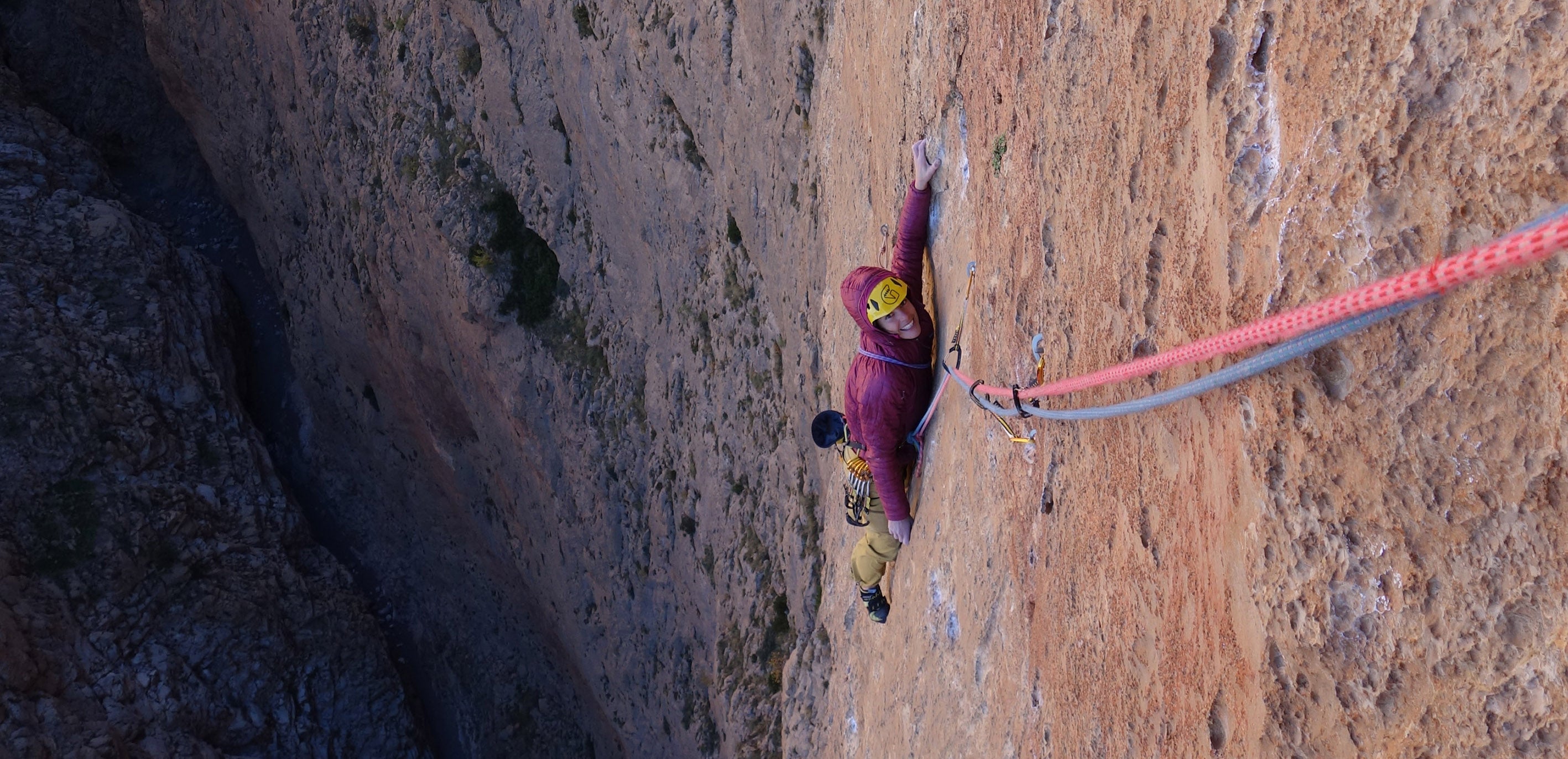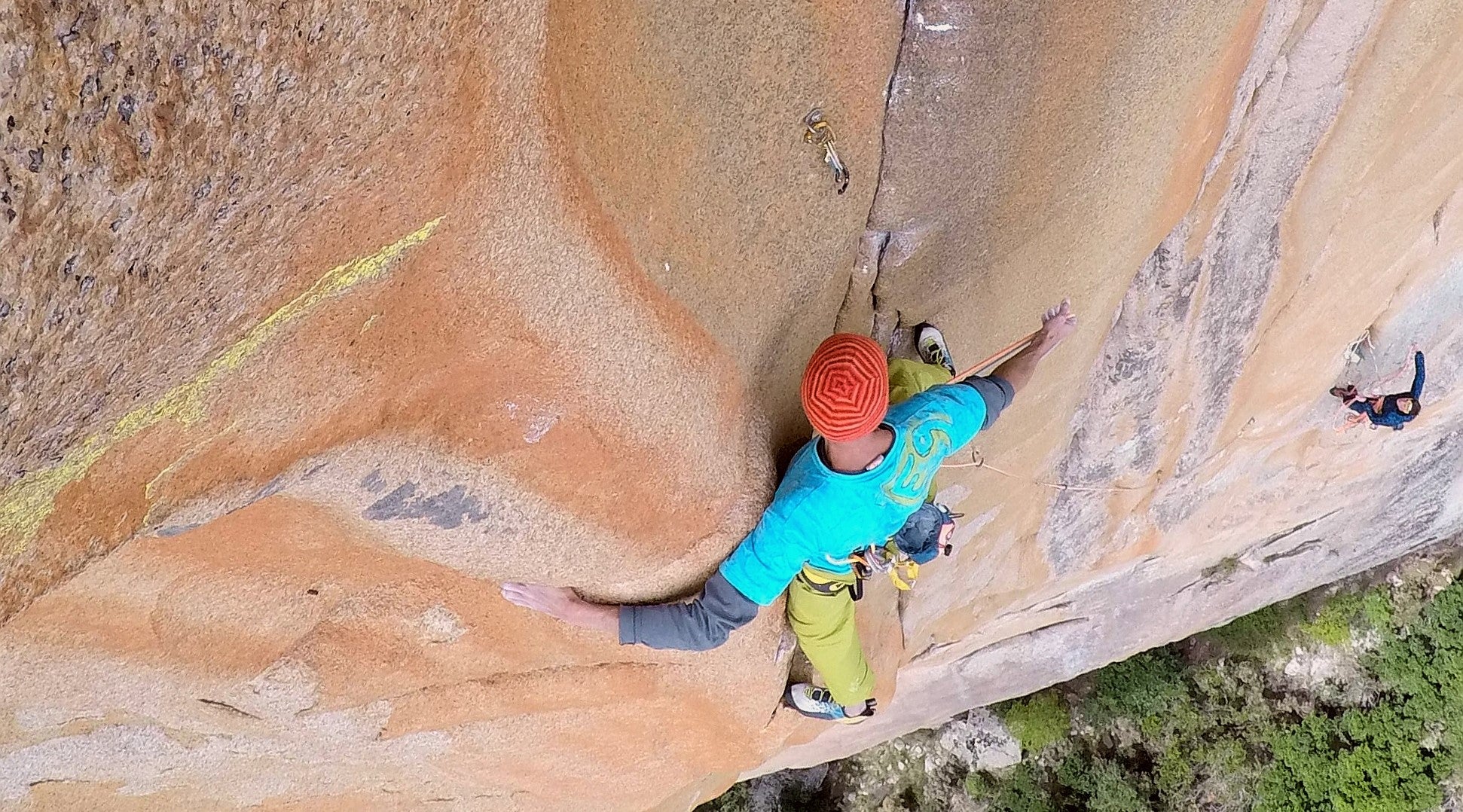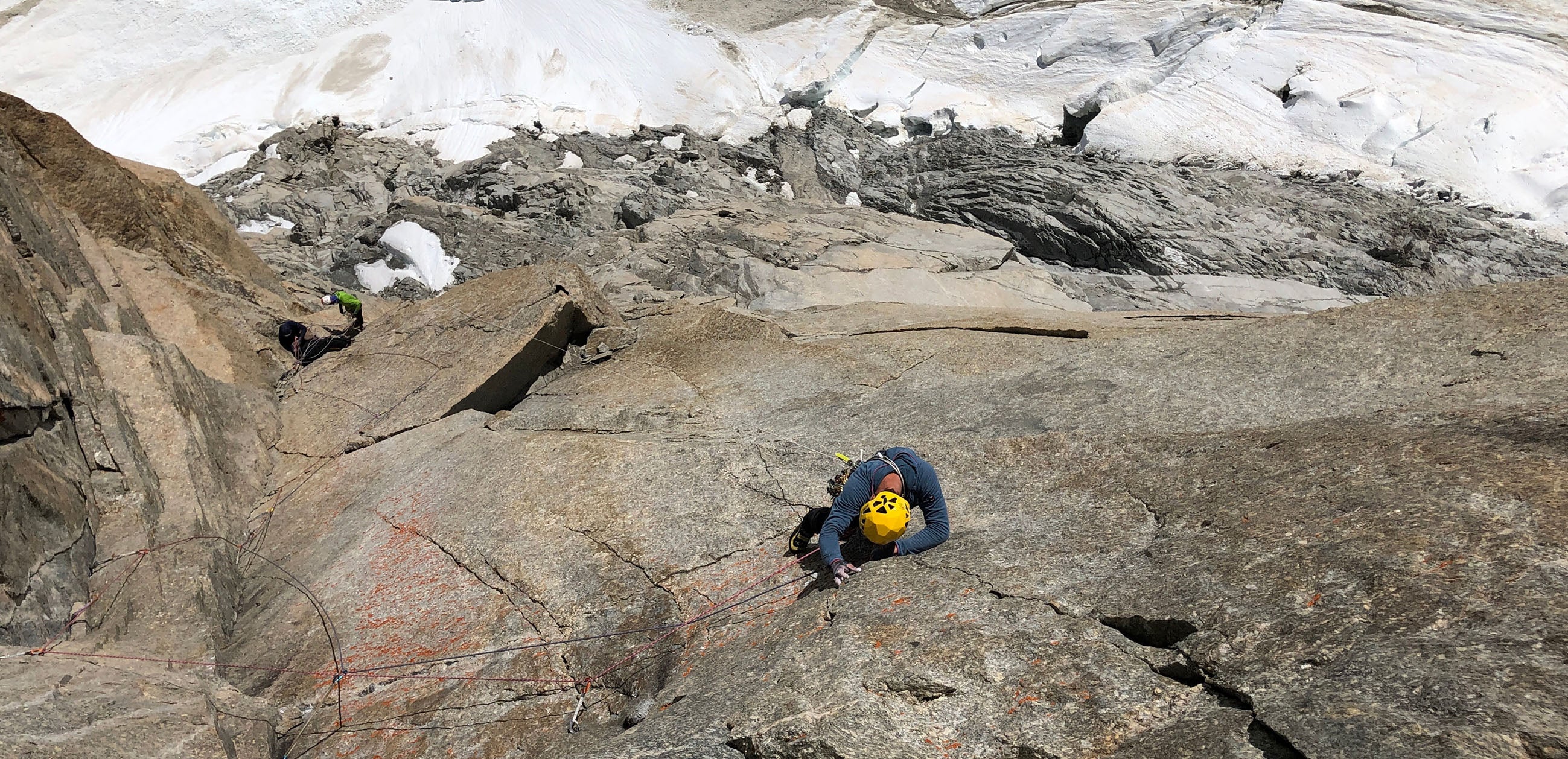
TAGHIA CLIMBING EXPEDITION - GOING INTO THE MOROCCAN MIDDLE ATLAS by Silvia Loreggian
Published on 30/06/2020
Taghia is a village of 600 inhabitants lost in the Moroccan Middle Atlas. Staying in Taghia means immersing yourself in another era and in a lifestyle that has nothing to do with ours. It is beautiful and interesting to discover different realities, it is one of the aspects that drives us to travel. At the same time, it can be difficult, both because our living chasing passions contrasts with their mere subsistence, and because having problems that for us "Westerners" would be solved in the pharmacy or with a car, over there are definitely serious problems.
 Just to better frame the environment, the best way to reach Taghia is from Marrakech (for which there are low cost flights from almost all the main Italian cities), from where then there are about 5/6 hours by taxi or bus towards North-East. Arriving to the village of Zahoiua, there are still 2 hours on foot on Berber paths that cross the stream and sometimes furrow rocky ledges to reach the destination of this trip.
Just to better frame the environment, the best way to reach Taghia is from Marrakech (for which there are low cost flights from almost all the main Italian cities), from where then there are about 5/6 hours by taxi or bus towards North-East. Arriving to the village of Zahoiua, there are still 2 hours on foot on Berber paths that cross the stream and sometimes furrow rocky ledges to reach the destination of this trip.
 A number of climbing activities have developed in the village of Taghia for several years now, which has prompted seven local families to create homes to welcome tourists with rich tajin dinners and a bed.
A number of climbing activities have developed in the village of Taghia for several years now, which has prompted seven local families to create homes to welcome tourists with rich tajin dinners and a bed.
The owners of the homes also offer their donkeys to help you carry the climbing equipment which, you know, weighs heavily on the shoulders.

Upon reaching the village after this long journey, in our eyes stands the imposing Oujdad, surrounded on the left and right by two deep canyons, which in turn divides into other canyons and which are dominated by vertical limestone walls that change color from orange to brown depending on the light of dawn, day or sunset. The walls to climb are many and of all lengths: from two hundred to nine hundred meters. Climbing is mainly of a sport climbing and presents surprisingly beautiful itineraries, given the excellent quality of the rock that has attracted "top" openers from all over Europe.

The best times to climb over there are the mid seasons: April-May and September-October. We arrived on November 3 and, after a week full of repetitions of beautiful routes (including "Les riviéres pourpres" on the Taoujdad and "Tout pour le club" on the Oujdad), we gave a day of rest to the skin of the our poor hands that now suffered from contact with this more than abrasive rock, to go into the canyons in search of a virgin wall where we can open our line. We find the wall, we identify the line and the following day we take care of transferring all the gear (therefore bolts, drill, ropes, quickdraws and various tools necessary for opening and sleeping bags, mats, stove, gas and food to stay at the inside the canyon several days without having to go back and forth from the village every day, being the wall a three hours walk from Taghia). We put the big bags in a cave near the wall and go back to the village, we decide to refresh ourselves and sleep in the home another night and the next day go up fresh and start the adventure.

 Unfortunately, the next day we are both sick in bed with a fever ranging between 38 and 39 and the only movements we can do are get up to vomit or go to the bathroom. We also discover that our material deposited in the cave is actually at the mercy of the shepherds, who usually steal climbing equipment (which is very rare in Morocco) and then resell it. With the anxiety of this big theft, we are forced to pay a local boy to transport all our material from the cave to what they call refuge (a half hour walk). The refuge is simply a stone cottage, kept under lock and key by the same shepherd who is the threat of theft; but apparently, if he is entrusted with the custody of the material (and paid for it), he will do well.
Unfortunately, the next day we are both sick in bed with a fever ranging between 38 and 39 and the only movements we can do are get up to vomit or go to the bathroom. We also discover that our material deposited in the cave is actually at the mercy of the shepherds, who usually steal climbing equipment (which is very rare in Morocco) and then resell it. With the anxiety of this big theft, we are forced to pay a local boy to transport all our material from the cave to what they call refuge (a half hour walk). The refuge is simply a stone cottage, kept under lock and key by the same shepherd who is the threat of theft; but apparently, if he is entrusted with the custody of the material (and paid for it), he will do well.
We live the next three days locked in the room and when on the fourth day we decide to try to stick our nose out ... A thin white blanket of snow has covered the entire valley! Do not worry, we will wait a few more days to recover our strength, above all in the hope that the temperatures will rise a bit.
The temperatures remain freezing, but we got tired of waiting and we leave for our adventure. How much cold we suffer! In the canyon where the water would flow there is ice. At the belay we have to dress warm: light down jacket, double thick down jacket, wool hat, headband and all possible hoods, shoes and socks (and despite this, our feet completely frozen). And the one of us who climbs on the wall with shoes and hands on the rock? Not even to describe! The wall we have chosen, among other things, is very difficult: the micro concretions that vary a bit the slab would be difficult to hold even with warm fingers!
 But let's jump back to some logistical details. First of all, we start early in Taghia with two light backpacks, already having all the gear at the refuge. The gear topic is truly paradoxical because we are going up hoping to find the so-called refuge-keeper (he does not answer the phone and we don’t know where he is) to whom we should also pay a sum for the custody (totally disengaged) of this gear, but we have been forced to rely on him to remove the gear from the shepherds' theft. And who is the only shepherd who is in the area? It’s him! So not only do we entrust our gear to our only potential thief, but we also have to pay for the service. And when we arrive, after an hour and a half of walking, the refuge is locked and obviously nobody is around. Let's try to find some traces of a night spent in one of the nearby caves, listen to the noises, repeatedly invoke his name ... Nothing, only the goats scattered on the nearby slopes answer us and the echo of our own voices. We give up and sit there waiting for someone to appear sooner or later. After half an hour, cold, we try to find the keys hidden under some boulders and ... luck, we find it! We can therefore recover our gear, we still curse on this refuge-keeper / shepherd / thief but at least not having met him we do not need to pay!
But let's jump back to some logistical details. First of all, we start early in Taghia with two light backpacks, already having all the gear at the refuge. The gear topic is truly paradoxical because we are going up hoping to find the so-called refuge-keeper (he does not answer the phone and we don’t know where he is) to whom we should also pay a sum for the custody (totally disengaged) of this gear, but we have been forced to rely on him to remove the gear from the shepherds' theft. And who is the only shepherd who is in the area? It’s him! So not only do we entrust our gear to our only potential thief, but we also have to pay for the service. And when we arrive, after an hour and a half of walking, the refuge is locked and obviously nobody is around. Let's try to find some traces of a night spent in one of the nearby caves, listen to the noises, repeatedly invoke his name ... Nothing, only the goats scattered on the nearby slopes answer us and the echo of our own voices. We give up and sit there waiting for someone to appear sooner or later. After half an hour, cold, we try to find the keys hidden under some boulders and ... luck, we find it! We can therefore recover our gear, we still curse on this refuge-keeper / shepherd / thief but at least not having met him we do not need to pay!
We reach the wall and take out all the equipment, we face the first pitch: easy, 50 meters of 6a and with many possibilities of cam protection. Upon reaching the ledge, we hoist all the material up here and attach the main wall. The sun warms us with its rays for a happy hour but then, it's freezing again. The wall presents really extreme difficulties for us with these temperatures and after three freezing hours on the wall, trying to bolt it from below, a nice pitch comes out of around 7c. It is now five o'clock, we mount the fixed ropes and take shelter from the wind down in the cave. In the cave it is paradise compared to what is going on outside: we light the fire (which makes more smoke than flame, but still does its own) and we consume a freeze-dried meal ... it seems very good after ten days of Moroccan diet! The typical tajin and the classic couscous are delicious, of course, but when after ten days that you always eat only these two dishes, without any variation in the cooking, a freeze-dried bag of “pappardelle with bolognaise sauce” has a completely different taste!

The next day is even colder than the previous one and the freezing wind never stops. We spend the day in search of invisible holds for hands and feet hoping to find sooner or later a discreet point where to place the cliff to bolt. The wind blows so constant that in the minutes we spend hanging on the bolt we turn into rigid marble statues. I leave you to imagine the vicissitudes to try to warm up to hanging there in the void. In the late afternoon with the wind growing and the turns of rope that begin to go horizontally we decide that perhaps it is no longer the case to continue, we leave a quick link and greet our project with the promise of returning next year …

A last harrowing walk with the big bags that crush us down and we are in Taghia, the forecasts give the weather still worsening, so we decide not to go back to the wall even for one last repetition.
We pack our bags, enjoy the last inevitable Tajin and the next day we walk with our faithful donkey towards Marrakech for the return flight.
A little sorry to have to leave a project on hold, but the beauty is that we have the excuse ready to be able to travel as soon as possible and return to finish it, in a hot spring week next time!
Featured Grivel products:
- Stealth helmet
- Grivel quickdraws
- Grivel harnesses
- Alpha K1N carabiner
- Haul Bag
- A&D ascender
- Master Pro belayer

Silvia Loreggian, born in Padova in 1990, lives in the Italian Dolomites and has been part of the Grivel team since 2016. Alpine guide, rock climber and mountaineer, has repeated itineraries symbol of climbing in the Dolomites and Mont Blanc areas. She has made expeditions to the most beautiful places on earth, including Patagonia, Morocco and Nepal.
Favorite Grivel Products: Tech Machine, Trail Three Poles, Grivel quickdraws.


